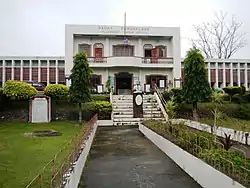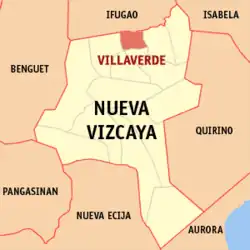Villaverde
Ibung | |
|---|---|
| Municipality of Villaverde | |
 Municipal Hall | |
 Flag  Seal | |
 Map of Nueva Vizcaya with Villaverde highlighted | |
OpenStreetMap | |
.svg.png.webp) Villaverde Location within the Philippines | |
| Coordinates: 16°36′24″N 121°10′58″E / 16.6067°N 121.1828°E | |
| Country | Philippines |
| Region | Cagayan Valley |
| Province | Nueva Vizcaya |
| District | Lone district |
| Named for | Padre Juan Villaverde |
| Barangays | 9 (see Barangays) |
| Government | |
| • Type | Sangguniang Bayan |
| • Mayor | Ronelie U. Valtoribio |
| • Vice Mayor | Kajong Eng. Acosta |
| • Representative | Luisa L. Cuaresma |
| • Electorate | 12,002 voters (2022) |
| Area | |
| • Total | 81.50 km2 (31.47 sq mi) |
| Elevation | 287 m (942 ft) |
| Highest elevation | 787 m (2,582 ft) |
| Lowest elevation | 213 m (699 ft) |
| Population (2020 census)[3] | |
| • Total | 20,118 |
| • Density | 250/km2 (640/sq mi) |
| • Households | 5,688 |
| Economy | |
| • Income class | 5th municipal income class |
| • Poverty incidence | 12.54 |
| • Revenue | ₱ 93.77 million (2020) |
| • Assets | ₱ 195.3 million (2020) |
| • Expenditure | ₱ 76.68 million (2020) |
| • Liabilities | ₱ 40.6 million (2020) |
| Service provider | |
| • Electricity | Nueva Vizcaya Electric Cooperative (NUVELCO) |
| Time zone | UTC+8 (PST) |
| ZIP code | 3710 |
| PSGC | |
| IDD : area code | +63 (0)78 |
| Native languages | Ilocano Tagalog |
| Website | www |
Villaverde, officially the Municipality of Villaverde (Ilocano: Ili ti Villaverde; Tagalog: Bayan ng Villaverde), also spelled as Villa Verde, is a 5th class municipality in the province of Nueva Vizcaya, Philippines. According to the 2020 census, it has a population of 20,118 people.[3]
Etymology
The town got its name in honor of the Spanish Missionary, father Juan Villaverde.
History
Spanish era
Villaverde was formerly a barrio of Solano, Nueva Vizcaya called Ibung, founded by a Dominican Friar named Alejandro Vidal in 1767. More than a century later, an order from the Spanish Government was issued to Father Juan Villaverde giving instruction to organize into a town. Thus, on May 28, 1872, Ibung became a town of the province of Nueva Vizcaya. Ibung was originally settled by christianized Ifugaos resettled from the area of Kiangan who later abandoned the town after a malaria epidemic in 1890, whereupon they were replaced by Ilocano migrants.[5]
American era
When the American took over, Ibung lost its status as a town because of insufficient funds. Moreover, most of the people residing in the area have transferred to an adjoining towns for fear of their lives from non-Christian tribes who dwelt in Cordillera mountains in the north-west part of the town. Ibung became a barangay of the municipality of Solano again .
Philippine independence
On June 17, 1957, through the sponsorship of the Congressman Leonardo B. Perez, Republic Act. No. 197 was enacted providing for the creation of the town Ibung through the separation of the barrios of Ibung and Bintawan from Solano.[6] On September 1, 1957, Antonio B. Aquino was appointed as the first mayor of Ibung.
Two years later, on June 21, 1959, Republic Act. No. 2515 was enacted amending Republic Act. No. 1972 changing the name of the town from Ibung to Villaverde in honor of Father Juan Villaverde who had organized the town. Romualdo Ubando was appointed as the first Municipal Mayor at that time. In 1963, Antonio B. Aquino was the first elected Mayor after renaming the town.
In 1986, the town's mayor, Romualdo Bediones, was abducted by the New People's Army and held until he was tried by a kangaroo court and executed in public.[7]
Geography
About 280 kilometres (170 mi) from Manila and 14 kilometres (8.7 mi) from the capital town of Bayombong; lies on the northern district of the province and is bounded by Lamut, Ifugao on the North; Solano on the South; Bagabag on the East, and Ambaguio on the West. Villaverde has a total land area of 81.50 square kilometers, the smallest town which accounts for 1.86% of the total land area of Nueva Vizcaya.
Barangays
Villaverde is politically subdivided into 9 barangays. Each barangay consists of puroks and some have sitios.
Barangay Poblacion where the Municipal Hall is located and Barangays Ibung, Bintawan Norte and Bintawan Sur as the commercial and educational center of the town.
- Bintawan Norte
- Bintawan Sur
- Cabuluan
- Ibung
- Nagbitin
- Ocapon
- Pieza
- Poblacion (Turod)
- Sawmill
Climate
| Climate data for Villaverde, Nueva Vizcaya | |||||||||||||
|---|---|---|---|---|---|---|---|---|---|---|---|---|---|
| Month | Jan | Feb | Mar | Apr | May | Jun | Jul | Aug | Sep | Oct | Nov | Dec | Year |
| Mean daily maximum °C (°F) | 24 (75) |
26 (79) |
28 (82) |
31 (88) |
31 (88) |
30 (86) |
30 (86) |
29 (84) |
29 (84) |
28 (82) |
26 (79) |
24 (75) |
28 (82) |
| Mean daily minimum °C (°F) | 19 (66) |
19 (66) |
20 (68) |
22 (72) |
23 (73) |
23 (73) |
23 (73) |
23 (73) |
23 (73) |
22 (72) |
21 (70) |
20 (68) |
22 (71) |
| Average precipitation mm (inches) | 119 (4.7) |
83 (3.3) |
54 (2.1) |
37 (1.5) |
133 (5.2) |
132 (5.2) |
161 (6.3) |
163 (6.4) |
153 (6.0) |
142 (5.6) |
160 (6.3) |
224 (8.8) |
1,561 (61.4) |
| Average rainy days | 18.4 | 13.6 | 11.6 | 9.4 | 19.3 | 21.9 | 23.9 | 23.4 | 21.1 | 16.3 | 18.1 | 21.4 | 218.4 |
| Source: Meteoblue[8] | |||||||||||||
Demographics
|
| |||||||||||||||||||||||||||||||||||||||
| Source: Philippine Statistics Authority[9][10][11][12] | ||||||||||||||||||||||||||||||||||||||||
In the 2020 census, Villaverde had a population of 20,118.[3] The population density was 250 inhabitants per square kilometre (650/sq mi).
Economy
Government
Local government
Villaverde, belonging to the lone congressional district of the province of Nueva Vizcaya, is governed by a mayor designated as its local chief executive and by a municipal council as its legislative body in accordance with the Local Government Code. The mayor, vice mayor, and the councilors are elected directly by the people through an election which is being held every three years.
Elected officials
| Position | Name |
|---|---|
| Congressman | Luisa L. Cuaresma |
| Mayor | Atty. Ronelie U. Valtoribio |
| Vice-Mayor | Engr. Marlon John R. Acosta |
| Councilors | Atty. Kruwel JD. Dacumos |
| Anastacio T. Mariñas, Jr. | |
| Braulio R. Ocumen, Jr. | |
| Johny P. Tuguinay | |
| Christine A. Peralta | |
| Jerry V. Jose | |
| Danilo E. Duro | |
| Rubbyrose U. Barrientos | |
Education
The Schools Division of Nueva Vizcaya governs the town's public education system. The division office is a field office of the DepEd in Cagayan Valley region.[21] The office governs the public and private elementary and public and private high schools throughout the municipality.
Secondary schools
- Bintawan National High School
- Our Lady of Fatima School of Villaverde
See also
References
- ↑ Municipality of Villaverde | (DILG)
- ↑ "2015 Census of Population, Report No. 3 – Population, Land Area, and Population Density" (PDF). Philippine Statistics Authority. Quezon City, Philippines. August 2016. ISSN 0117-1453. Archived (PDF) from the original on May 25, 2021. Retrieved July 16, 2021.
- 1 2 3 Census of Population (2020). "Region II (Cagayan Valley)". Total Population by Province, City, Municipality and Barangay. Philippine Statistics Authority. Retrieved 8 July 2021.
- ↑ "PSA Releases the 2018 Municipal and City Level Poverty Estimates". Philippine Statistics Authority. 15 December 2021. Retrieved 22 January 2022.
- ↑ Salgado, Pedro. "Various Towns of Nueva Vizcaya". Cagayan Valley and Easter Cordillera: 1581-1898, Volume II. Rex Publishing. pp. 876–881.
- ↑ "An Act Creating the Municipality of Ibung, Province of Nueva Vizcaya". LawPH.com. Retrieved 2011-04-13.
- ↑ "Foreign News Briefs". UPI. January 13, 1986. Retrieved August 19, 2022.
- ↑ "Villaverde: Average Temperatures and Rainfall". Meteoblue. Retrieved 4 July 2021.
- ↑ Census of Population (2015). "Region II (Cagayan Valley)". Total Population by Province, City, Municipality and Barangay. Philippine Statistics Authority. Retrieved 20 June 2016.
- ↑ Census of Population and Housing (2010). "Region II (Cagayan Valley)" (PDF). Total Population by Province, City, Municipality and Barangay. National Statistics Office. Retrieved 29 June 2016.
- ↑ Censuses of Population (1903–2007). "Region II (Cagayan Valley)". Table 1. Population Enumerated in Various Censuses by Province/Highly Urbanized City: 1903 to 2007. National Statistics Office.
{{cite encyclopedia}}: CS1 maint: numeric names: authors list (link) - ↑ "Province of Nueva Vizcaya". Municipality Population Data. Local Water Utilities Administration Research Division. Retrieved 17 December 2016.
- ↑ "Poverty incidence (PI):". Philippine Statistics Authority. Retrieved December 28, 2020.
- ↑ "Estimation of Local Poverty in the Philippines" (PDF). Philippine Statistics Authority. 29 November 2005.
- ↑ "2003 City and Municipal Level Poverty Estimates" (PDF). Philippine Statistics Authority. 23 March 2009.
- ↑ "City and Municipal Level Poverty Estimates; 2006 and 2009" (PDF). Philippine Statistics Authority. 3 August 2012.
- ↑ "2012 Municipal and City Level Poverty Estimates" (PDF). Philippine Statistics Authority. 31 May 2016.
- ↑ "Municipal and City Level Small Area Poverty Estimates; 2009, 2012 and 2015". Philippine Statistics Authority. 10 July 2019.
- ↑ "PSA Releases the 2018 Municipal and City Level Poverty Estimates". Philippine Statistics Authority. 15 December 2021. Retrieved 22 January 2022.
- ↑ "2019 National and Local Elections" (PDF). Commission on Elections. Retrieved March 10, 2022.
- ↑ "DEPED REGIONAL OFFICE NO. 02". DepED RO2 | The official website of DepED Regional Office No. 02.